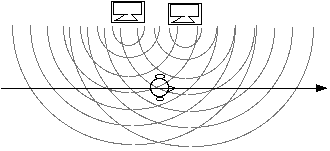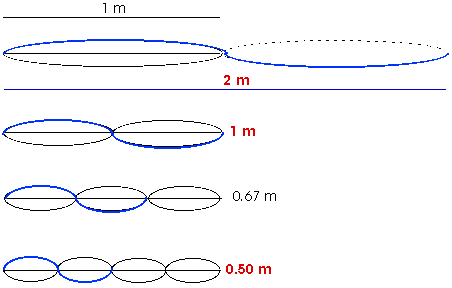

(this is Chapter 11 of Adventures in Physics, available only online)
Ch 11, Waves; 1, 3, 7, 8, 9, 12, 14, 15
![]()
1. If the frequency of a wave is increased, what happens to its wavelength?
As the frequency increases, the wavelength decreases.
2. If the frequency of a wave is doubled, what happens to its wavelength?
If the frequency is doubled, the wavelength is only half as long.
3. If you put your fingertip in a pool of water and repeatedly move it up and down, you will create circular water waves that move out from that point. What will happen to the wavelength of these waves if you move your finger up and down more slowly (or less frequently)?
As the frequency slows down, the wavelength increases.
4. As a wave goes by, how far does it move during one period?
During each period, the wave moves one wavelength.
5. If the amplitude of a wave is increased 10%, what happens to the wave speed?
The wavespeed does not change with the period.
6. Can a transverse wave travel along a Slinky toy?
A Slinky toy can support both a transverse wave and a longitudinal wave.
7. Can a sound wave be polarized?
Sound is a longitudinal wave so it can not be polarized.
8. Can a light wave be polarized?
Light is a transverse wave so it can be polarized.
9. If exactly the same signal is sent to two speakers, what will a listener hear as she walks along a line parallel to the speakers (as illustrated in the sketch)?

The sound waves from the two speakers will add together by superposition. At some points, the two sound waves will be pushing the air molecules in the same direction and we will hear a large amplitude; this is called constructive interference or a sound maximum. At other points, the two sound waves will be pushing the air molecules in the opposite direction and we will hear a small amplitude; this is called destructive interference or a sound minimum.
12. Why does the amplitude of a water wave decrease as the wave spreads out from its source?
The energy -- or power -- in the wave is spread out over a greater area so the amplitude is smaller.
14. Carefully hold a metal rod horizontally at its mid-point. If you then strike it horizontally on its end, what kind of wave will be created in the rod? If you then strike it vertically on its end, what kind of wave will be created in the rod? Will the sound you hear be the same or different for these two cases? Why?
Striking it horizontally on its end should cause a longitudinal wave through the rod. Striking it vertically on its end should cause a transverse wave along the rod. The two waves are quite different so their wave velocities will be quite different and, therefore, their resonant frequencies will be quite different. That is, the sound produced will be quite different.
15. Describe some common examples of resonance.
Perhaps the first example of resonance that comes to mind is the resonance of a pendulum as seen in a common playground swing. The resonance of a pendulum in a clock is another ready example. Resonance is also used in tuning a radio or television. Resonance of air molecules is involved in the blue color of the sky. Resonance is used in every musical instrument.
Typical Multiple Choice Questions:
1. Like a transverse wave, a longitudinal wave has a/an
A) amplitudeB) frequency
C) wavelength
D) all of the above
2. Which of the following is a longitudinal wave?
A) lightB) wave on a string
C) sound
D) all of the above
3. The individual vibrations or disturbances of a transverse wave move
A) in the same direction as the wave itselfB) perpendicular to the wave itself
4. A wave has a frequency of 100 Hz and travels 25 m in one second. It has
A) a wave speed of 25 m/s and a wavelength of 4 m.B) a wave speed of 25 m/s and a wavelength of 0.25 m.
C) a wave speed of 100 m/s and a wavelength of 25 m
D) a wave speed of 100 m and a wavelength of 4 m
5. For standing waves, nodes are
A) always a wavelength apartB) regions of greatest amplitude
C) regions of greatest frequency
D) always two wavelengths apart
6. For standing waves, antinodes
A) are half a wavelength apartB) have the greatest amplitude
C) alternate with nodes
D) all of the above
7. For standing waves on a string,
A) a node is located at each endB) a whole number times half the wavelength equals the length of the string
C) the whole "pattern" of standing waves occurs only for certain frequencies
D) all of the above
8. For standing waves on a string,
A) an antinode is located at each endB) the length of the string equals the wavelength divided by a whole number
C) the amplitude is proportional to the frequency
D) all of the above
E) none of the above
9. On a string that is 1.0 m long, standing waves may be formed with the following wavelengths:
A) 1.0 m, 2.0 m, 3.0 mB) 1.0 m, 2.0 m, 4.0 m
C) 3.0 m, 1.5 m, 0.75 m
D) 2.0 m, 1.0 m, 0.5 m

20. Standing waves can occur when
A) the frequency equals the wavelengthB) the amplitude exceeds the wavelength
C) a wave is reflected back on itself
D) a wave's period equals its wavelength
11. A node is
A) always in the middle of a standing waveB) a position of maximum amplitude
C) a position of minimum amplitude
D) equal to the fundamental frequency
12. A bobber on a fishing line oscillates up and down three times per second as waves pass by. The waves have a frequency of
A) (1/3) HzB) 3 Hz
C) (1/3) sec
D) 3 sec
13. A bobber on a fishing line oscillates up and down two times per second as waves pass by. The waves have a wavelength of 10 cm. The waves are traveling at
A) 5 cm/sB) 10 cm/s
C) 20 cm/s
D) 980 cm/s
14. If you put your fingertip in a pool of water and repeatedly move it up and down, you will create circular water waves that move out from that point. What will happen to the wavelength of these waves if you move your finger up and down more slowly (or less frequently)?
A) increaseB) remain the same
C) decrease
Answers to these Typical Multiple Choice Questions:
1. Like a transverse wave, a longitudinal wave has a/an
A) amplitudeB) frequency
C) wavelength
D) all of the above
2. Which of the following is a longitudinal wave?
A) lightB) wave on a string
C) sound
D) all of the above
3. The individual vibrations or disturbances of a transverse wave move
A) in the same direction as the wave itselfB) perpendicular to the wave itself
4. A wave has a frequency of 100 Hz and travels 25 m in one second. It has
A) a wave speed of 25 m/s and a wavelength of 4 m.B) a wave speed of 25 m/s and a wavelength of 0.25 m.
v = (wavelength) x (frequency)v = 25 m/s = (wavelength) x (100 Hz)
25 m/s = (wavelength) x (100 1/s)
wavelength = 0.25 m
C) a wave speed of 100 m/s and a wavelength of 25 m
D) a wave speed of 100 m and a wavelength of 4 m
5. For standing waves, nodes are
A) always a wavelength apart; nodes are half a wavelength apartB) regions of greatest amplitude; nodes have minimum (zero!) amplitude
C) regions of greatest frequency; all parts of a standing wave have the same frequency
D) always two wavelengths apart ; nodes are half a wavelength apart
E) none of the above
6. For standing waves, antinodes
A) are half a wavelength apartB) have the greatest amplitude
C) alternate with nodes
D) all of the above
7. For standing waves on a string,
A) a node is located at each endB) a whole number times half the wavelength equals the length of the string
C) the whole "pattern" of standing waves occurs only for certain frequencies
D) all of the above
8. For standing waves on a string,
A) an antinode is located at each endB) the length of the string equals the wavelength divided by a whole number
C) the amplitude is proportional to the frequency
D) all of the above
E) none of the above
9. On a string that is 1.0 m long, standing waves may be formed with the following wavelengths:
A) 1.0 m, 2.0 m, 3.0 mB) 1.0 m, 2.0 m, 4.0 m
C) 3.0 m, 1.5 m, 0.75 m
D) 2.0 m, 1.0 m, 0.5 m

10. Standing waves can occur when
A) the frequency equals the wavelengthB) the amplitude exceeds the wavelength
C) a wave is reflected back on itself
D) a wave's period equals its wavelength
11. A node is
A) always in the middle of a standing waveB) a position of maximum amplitude
C) a position of minimum amplitude
D) equal to the fundamental frequency
12. A bobber on a fishing line oscillates up and down three times per second as waves pass by. The waves have a frequency of
A) (1/3) HzB) 3 Hz
C) (1/3) sec
D) 3 sec
13. A bobber on a fishing line oscillates up and down two times per second as waves pass by. The waves have a wavelength of 10 cm. The waves are traveling at
A) 5 cm/sB) 10 cm/s
C) 20 cm/s
f = 2 Hz = 2 cyc/sv = (wavelength) x (frequency)
v = (10 cm) x ( 2 / s)
v = 20 cm/s
D) 980 cm/s
14. If you put your fingertip in a pool of water and repeatedly move it up and down, you will create circular water waves that move out from that point. What will happen to the wavelength of these waves if you move your finger up and down more slowly (or less frequently)?
A) increasev = (wavelength) x (frequency)A decrease in frequency means an increase in wavelength.
B) remain the same
C) decrease
| Back to 3050's Home Page | Back to Calendar | ToC, Ch 11 | Ch 12, Sound and Music |
![]()
(C) 2003, Doug Davis; all rights reserved